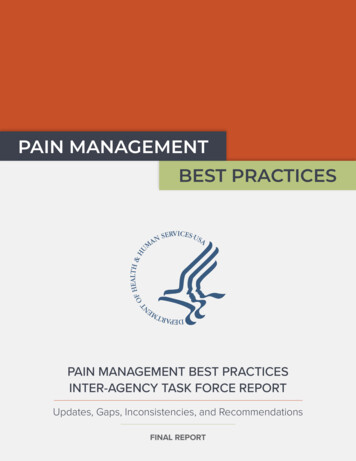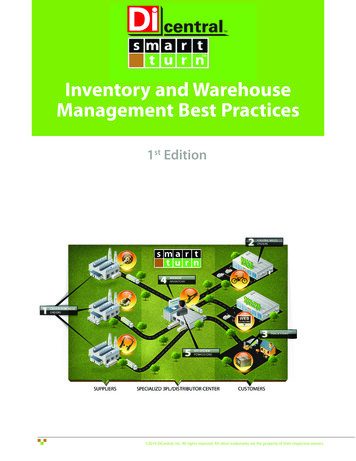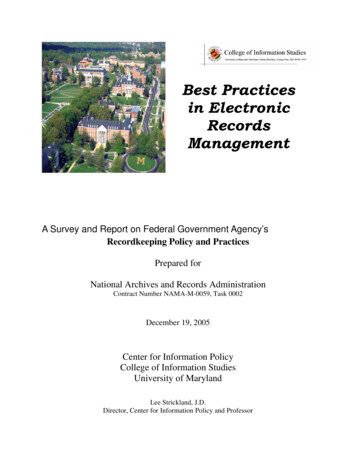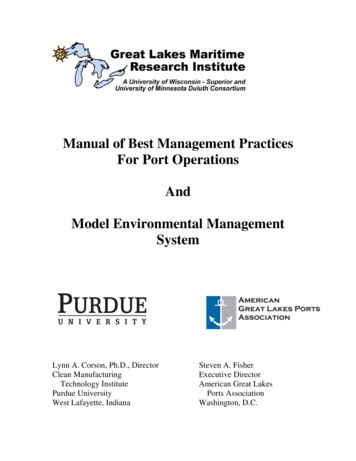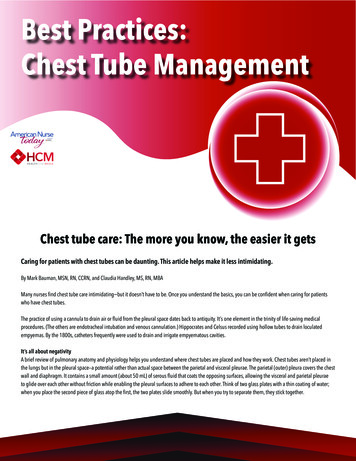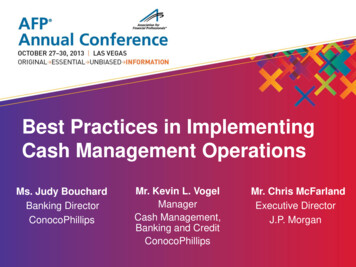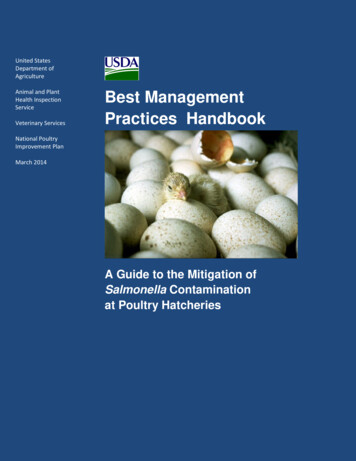
Transcription
United StatesDepartment ofAgricultureAnimal and PlantHealth InspectionServiceVeterinary ServicesBest ManagementPractices HandbookNational PoultryImprovement PlanMarch 2014A Guide to the Mitigation ofSalmonella Contaminationat Poultry Hatcheries
Best Management Practices Handbook: A Guide to the Mitigation ofSalmonella at Poultry HatcheriesUnited States Department of AgricultureAnimal and Plant Health Inspection ServiceVeterinary ServicesNational Poultry Improvement PlanContactUSDA-APHIS-VSNational Poultry Improvement Plan1506 Klondike Rd. Suite 101Conyers, GA 30094(770)922-3496Suggested bibliographic citation for this reportUSDA (2014). Best Management Practices Handbook: A Guide to the Mitigation of SalmonellaContamination at Poultry Hatcheries. USDA-APHIS-VS-National Poultry Improvement Plan, Conyers, GA.March 2014.The U.S. Department of Agriculture (USDA) prohibits discrimination in all its programs and activities on the basis of race, color, national origin,age, disability, and where applicable, sex, marital status, familial status, parental status, religion, sexual orientation, genetic information,political beliefs, reprisal, or because all or part of an individual's income is derived from any public assistance program. (Not all prohibited basesapply to all programs.)Persons with disabilities who require alternative means for communication of program information (Braille, large print, audiotape, etc.) shouldcontact USDA's TARGET Center at (202) 720-2600 (voice and TDD).To file a complaint of discrimination, write USDA, Director, Office of Civil Rights, 1400 Independence Avenue, SW, Washington, DC 20250-9410or call (800) 795-3272 or (202) 720-6382 (TDD). USDA is an equal opportunity provider and employer.Mention of companies or commercial products does not imply recommendation or endorsement by the U.S. Department of Agriculture overothers not mentioned. USDA neither guarantees nor warrants the standard of any product mentioned. Product names are mentioned solely toreport factually on available data and to provide specific information.
BMPs Handbook: A Guide to Mitigation of Salmonella at Poultry HatcheriesMarch 24, 2014Table of ContentsAbout This Handbook. 3Introduction . 3Salmonella in Poultry . 4Biosecurity . 6Handling Hatching Eggs. 7Egg Sanitation Procedures . 7Vehicles and Equipment . 8Rodents, Wild Birds, Other Animals, and Insects . 8Hatchery Facility. 8Employees and Visitors . 9Sanitation Program . 10Hatcher, Hatcher Room, and Take-Off Area . 10Walls, Floors, Ceilings, Windows, Fans, Ducting, and Machines . 10Minimum Sanitation Requirements. 11Cleanup of Incubators, Hatchers and Hatchery Rooms, and Equipment . 11Quality Assurance Program . 14Education of Consumers . 14Conclusion . 15Reference List. 15Appendix A . 18Sample Questionnaire for Hatchery Manager . 18United States Department of Agriculture - National Poultry Improvement PlanPage 2
BMPs Handbook: A Guide to Mitigation of Salmonella at Poultry HatcheriesMarch 24, 2014About This HandbookThis handbook was developed to assist hatchery operators in mitigating Salmonellacontamination of birds to be sold through the mail, feed stores, or other retail outlets.Reducing Salmonella contamination at the hatchery, along with proper handling of livepoultry by those purchasing birds, will help reduce the number of people becoming ill. Thebiosecurity, sanitation, and quality assurance recommendations made in this handbook arevery basic approaches to improving the quality of the birds produced at a hatchery andreducing the risk of Salmonella transmission. A Salmonella control program specificallydesigned for an individual hatchery should be developed in collaboration with aprofessional poultry health consultant such as a poultry veterinarian.IntroductionSalmonella bacteria causean estimated 1.2 millionhuman illnesses, 19,000hospitalizations, and 370deaths annually in theUnited States. The UnitedStates Department ofAgriculture’s (USDA)Economic Research Serviceestimates that Salmonellacosts the U.S. economyapproximately 2.5 billionannually. An estimated11% of human SalmonellaCDC Graphicinfections are attributed to animalexposure annually, making it important for producers, public health and agricultureofficials, health care providers, pertinent industries, and consumers to be aware of thiszoonotic disease. Live poultry, reptiles, amphibians, cattle, sheep, pigs, horses, dogs, cats,and many other animals have been identified as sources for human Salmonella infection.Infections are caused by direct or indirect contact with animals. Indirect transmission canoccur through contact with anything in areas where animals live and roam or consumptionof food/drink prepared in contaminated environments. Live poultry infected withSalmonella typically appear healthy, but can intermittently shed bacteria. Infections haveoccurred in a variety of public and private settings such as farms, feed stores, county fairs,child care facilities, schools, veterinary clinics, and homes.United States Department of Agriculture - National Poultry Improvement PlanPage 3
BMPs Handbook: A Guide to Mitigation of Salmonella at Poultry HatcheriesMarch 24, 2014How does a hatchery become contaminated with Salmonella?How Salmonella canspread within a flock Contaminated hatching eggs from an infected breederflockRodents or other animals/wild birds carrying theSalmonella bacteriumInsects mechanically spreading the organismContamination from equipment, incoming andoutgoing trucks, feed, workers or caretakers, visitors,or water sourcesThe Salmonella bacteriumcan spread from bird tobird in a flock throughdirect contact, indirectcontact (environmentalcontamination and/oringestion of feces or fecalcontaminated feed, soil,dander, feathers, etc.), orfrom an infected hen toher offspring through oron her eggs.Live poultry play a particularly important role in transmitting salmonellosis to humans.More people are raising chickens and other poultry in their backyards for meat and eggproduction, or for hobby. The risk of human salmonellosis after contact with live poultrysuch as chicks, ducklings and other live poultry, including those in backyard flocks, hasbeen well documented through numerous large outbreaks. According to the Centers forDisease Control and Prevention (CDC), 45 outbreaks of human Salmonella infections linkedto live poultry have been documented from 1996-2012, resulting in 1,581 illnesses, 221hospitalizations, and 5 deaths. Because only a portion of Salmonella infections arediagnosed and reported, many more infections likely occurred in association with theseoutbreaks. A thorough summary of these outbreaks was recently published.Approximately 20 core U.S. hatcheries produce over 50 million chicks annually, which aresold online, through feed stores, and by mail order. In most documented outbreaks ofhuman salmonellosis linked to live poultry contact, infection can be traced back to a singlehatchery or hatcheries, highlighting the importance of reducing Salmonella bacteria at thehatchery level.Salmonella in PoultryMore than 2,500 serotypes of Salmonella species of bacteria have been identified. Someserotypes have frequently been associated with foodborne illnesses and some inhabit theUnited States Department of Agriculture - National Poultry Improvement PlanPage 4
BMPs Handbook: A Guide to Mitigation of Salmonella at Poultry HatcheriesMarch 24, 2014intestinal tract of chickens and other poultry. Typically, poultry carrying Salmonellabacteria appear healthy and clean despite shedding many different Salmonella serotypesthat can cause illness in people; additionally, shedding can be intermittent. Past researchhas shown that as many as 30 Salmonella serotypes have been identified being carried bypoultry.Eggs can be infected during formation in an infected hen’s reproductive tract (calledtransovarial transmission) or horizontal transmission after the egg is laid and iscontaminated by fecal material from an infected bird. The bacterium can penetrate theshell and vitelline membrane. Once inside the egg, the Salmonella bacterium rapidlyreplicates to an infective dose level.How is Salmonella infection spread from live poultry to humans?Live poultry (including day-old chicks, ducklings, goslings andpoults) may have Salmonella bacteria in their droppings and ontheir bodies (feathers, feet, and beaks) even when they appearhealthy and clean. The bacteria can also contaminate cages,coops, chick/poult boxes, bedding, plants, and soil in the areawhere the birds live and roam.Additionally, Salmonella bacteria can be found on the hands,shoes, and clothing of those who handle the birds or work orplay near the birds. People can become infected withSalmonella when they put their hands in or around their mouthafter touching or coming into contact with fecal material,inhaling contaminated dust, or touching contaminated objects.United States Department of Agriculture - National Poultry Improvement PlanPage 5
BMPs Handbook: A Guide to Mitigation of Salmonella at Poultry HatcheriesBiosecurityBiosecurity is thedevelopment andimplementation of thepractices, procedures,and programs toprotect poultryproduction systems from unwantedmicrobes.Proper biosecuritymeasures can: The major sources of Salmonella entering ahatchery are: incoming eggs (contaminatedwith feces, feather, and litter), people,rodents, insect vectors, and equipment. March 24, 2014Prevent the entry of diseasecausing organisms into a facilityor areaControl the spread of diseasecausing organisms within afacility or areaEliminate the disease-causingorganisms in the facility or areaHatcheries participating in the National Poultry Improvement Plan(NPIP) Salmonella control programs can minimize the risk of importingSalmonella-contaminated eggs into the hatchery. Participating breederflocks must demonstrate that they are U.S. Pullorum-Typhoid Clean, U.S.S. Enteritidis Clean, U.S. Salmonella Monitored, and U.S. SanitationMonitored. This status may apply to the following types of breedingflocks and products (9 CFR Part 145):Multiplier egg-type chickenMultiplier meat-type chickenBreeding turkeysBreeding hobbyist and exhibition waterfowl,poultry, and game birdsPrimary egg-type chickensPrimary meat-type chickensBreeding meat-type waterfowlNPIP in 2010 ratified a new voluntary monitoringprogram for mail-order hatcheries, which proposesmonthly environmental sampling of the hatchery forSalmonella. Once this NPIP classification becomesofficial, mail-order hatcheries may voluntarilychoose to participate and enhance control of allSalmonella serotypes.United States Department of Agriculture - National Poultry Improvement PlanPage 6
BMPs Handbook: A Guide to Mitigation of Salmonella at Poultry HatcheriesMarch 24, 2014Biosecurity for the hatchery must begin at the breeder farms producing the hatching eggs.The production of top grade and healthy chicks/poults from the hatchery depends oncareful attention to detail, starting with the arrival of the breeding stock from NPIPparticipating hatcheries on the farm, testing arriving chick/poults papers for Salmonella, tothe collection and dispatch of hatching eggs, to the delivery of the chicks to their finaldestination.Handling Hatching EggsCollect hatching eggs from nests frequently to prevent contamination with diseasecausing organisms.Use cleaned and disinfected containers, such as egg flats, to collect eggs for hatching.Egg handlers should wear clean outer garments and thoroughly wash hands withsoap and
Improvement Plan . March 2014 . Best Management Practices Handbook: A Guide to the Mitigation of Salmonella at Poultry Hatcheries United States Department of File Size: 1MBPage Count: 25



